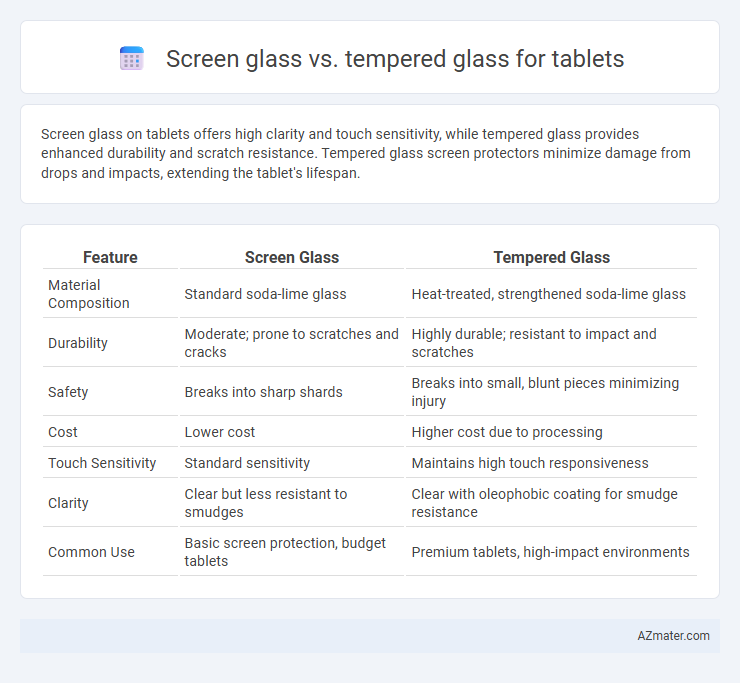Screen glass on tablets offers high clarity and touch sensitivity, while tempered glass provides enhanced durability and scratch resistance. Tempered glass screen protectors minimize damage from drops and impacts, extending the tablet's lifespan.
Table of Comparison
| Feature | Screen Glass | Tempered Glass |
|---|---|---|
| Material Composition | Standard soda-lime glass | Heat-treated, strengthened soda-lime glass |
| Durability | Moderate; prone to scratches and cracks | Highly durable; resistant to impact and scratches |
| Safety | Breaks into sharp shards | Breaks into small, blunt pieces minimizing injury |
| Cost | Lower cost | Higher cost due to processing |
| Touch Sensitivity | Standard sensitivity | Maintains high touch responsiveness |
| Clarity | Clear but less resistant to smudges | Clear with oleophobic coating for smudge resistance |
| Common Use | Basic screen protection, budget tablets | Premium tablets, high-impact environments |
Introduction to Tablet Screen Glass Types
Tablet screen glass types primarily include regular screen glass and tempered glass, each offering distinct durability and clarity features. Regular screen glass provides basic protection and touch responsiveness but is more prone to scratches and cracks. Tempered glass undergoes heat treatment to enhance strength, making it highly resistant to impacts and shattering, which significantly improves the tablet's durability and lifespan.
What is Standard Screen Glass?
Standard screen glass for tablets is typically made from chemically strengthened glass that offers basic scratch resistance and clarity but lacks high impact durability. It provides a smooth touch experience and clear visibility but is more prone to cracks and shattering under stress compared to tempered glass. Tempered glass undergoes a heat treatment process that significantly increases its toughness, making it an ideal choice for enhanced protection against drops and impacts on tablet screens.
Understanding Tempered Glass for Tablets
Tempered glass for tablets is engineered through a controlled heating and rapid cooling process, significantly increasing its strength compared to regular screen glass. This enhanced durability provides superior resistance to scratches and impacts, making it ideal for protecting delicate tablet displays. Tempered glass also maintains high transparency and touchscreen sensitivity, ensuring an optimal user experience without compromising the device's visual or functional quality.
Key Differences Between Screen Glass and Tempered Glass
Screen glass on tablets is typically made from durable, smooth materials designed for touch sensitivity and visual clarity, while tempered glass is a heat-treated, stronger protective layer applied as a screen protector. Tempered glass offers superior scratch resistance, impact protection, and shatter resistance compared to standard screen glass. The key difference lies in tempered glass serving as an external protective barrier enhancing durability, whereas screen glass forms the integral touch-sensitive display surface of the tablet.
Durability Comparison: Screen Glass vs Tempered Glass
Tempered glass offers superior durability compared to regular screen glass for tablets, providing enhanced resistance to scratches, impacts, and shattering. It undergoes a heat treatment process that strengthens its structure, making it less prone to cracking under pressure or accidental drops. Screen glass, while still protective, is generally more fragile and susceptible to damage from everyday wear and tear.
Impact and Scratch Resistance: Which is Better?
Tempered glass offers superior impact resistance for tablets due to its enhanced strength and ability to absorb shocks, significantly reducing the risk of screen breakage. Screen glass, typically made from regular glass or plastic, provides less protection against drops but may perform adequately against minor scratches. For optimal scratch resistance combined with durability, tempered glass is generally the better choice, providing a robust shield that preserves tablet display integrity.
Clarity and Touch Sensitivity Analysis
Tempered glass offers superior clarity with high light transmittance, ensuring vivid and sharp display visuals on tablets, while screen glass sometimes causes slight distortion due to lower optical quality. Touch sensitivity in tempered glass remains highly responsive, preserving the tablet's original touch experience by maintaining minimal interference with the capacitive sensors. Compared to regular screen glass, tempered glass provides enhanced durability without compromising clarity or touch precision, making it optimal for tablet screen protection.
Cost Considerations: Screen Glass vs Tempered Glass
Screen glass for tablets typically costs less upfront compared to tempered glass, which is engineered to offer enhanced durability and impact resistance. Tempered glass screen protectors may have a higher initial price but can reduce long-term replacement costs by preventing cracks and scratches. Choosing between these options depends on balancing budget constraints with the need for stronger, more reliable screen protection.
Application Scenarios: When to Choose Each Type
Screen glass is ideal for tablet devices primarily used in low-impact environments such as office settings or casual home use, where touch clarity and scratch resistance are priorities but extreme durability is less critical. Tempered glass is better suited for tablets utilized in rugged or high-risk conditions like outdoor work sites, school environments, or by children, offering superior impact resistance and shatter protection. Selecting screen glass ensures optimal display performance under light use, while tempered glass provides reliable safeguarding against drops and heavy wear.
Final Verdict: Best Glass Option for Your Tablet
Tempered glass offers superior durability and impact resistance compared to regular screen glass, making it the best choice for tablet protection. It provides enhanced scratch resistance and better shock absorption, significantly reducing the risk of screen damage from drops or bumps. For optimal long-term protection and clarity, tempered glass screen protectors are the recommended option for tablet users seeking to safeguard their device effectively.

Infographic: Screen glass vs Tempered glass for Tablet
 azmater.com
azmater.com